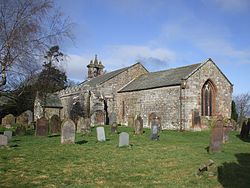Torpenhow
| Torpenhow | |
| Cumberland | |
|---|---|
 The Church of St Michael and All Angels, Torpenhow | |
| Location | |
| Grid reference: | NY178415 |
| Location: | 54°45’43"N, 3°16’42"W |
| Data | |
| Post town: | Wigton |
| Postcode: | CA7 |
| Local Government | |
| Council: | Cumberland |
Torpenhow is a village in western Cumberland. According to the 2001 census, the parish of 'Blennerhasset and Torpenhow' had a population of 437, reduced to 423 at the 2011 Census.
Name
The name 'Torpenhow' is said to be a triple-word tautology. One etymology has it that the name means "Tosti's hill", from the Old Norse haugr meaning "hill" or "mound", which becomes How in today's place-names.[1]
However the more usual tradition is that the name means "Hill" I two or three languages, making it "Hill-hill-hill"; an etymology first proposed by Thomas Denton in 1688.[2] Denton interpreted tor, pen and how as three elements all with the base meaning "hill", in Old English, Old Welsh and Old Norse. The Concise Oxford Dictionary of English Placenames (4th ed. 1960) accepted Denton's torr+pen+howe etymology (against the 1950s "Tosti" proposal), but notes that torr+penn is not tautological, but can be wholly Old Welsh expressng the idea of "top or breast of the hill", to which howe (haugr) was added, leaving it a single tautology.[3]
The hill on whose side the village stands is not named on Ordnance Survey maps but it does not appear ever to have been known as 'Torpenhow Hill' ('Hill-hill-hill Hill').
The local pronunciation of Torpenhow Village is [trəpɛnə], though the more intuitive pronunciation [tɔrpənhaʊ] is also heard, amongst visitors at least.[4]
Outside links
| ("Wikimedia Commons" has material about Torpenhow) |
References
- ↑ Armstrong, 1950, p.266
- ↑ Thomas Denton: A Perambulation of Cumberland, 1687-8, including descriptions of Westmorland, the Isle of Man and Ireland
- ↑ the same etymology is also accepted y David Mills, 2011, A Dictionary of British Place-Names.
- ↑ Darryl Francis (2003). "The Debunking of Torpenhow Hill". Word Ways 36 (1): 6–8. http://digitalcommons.butler.edu/cgi/viewcontent.cgi?article=4733&context=wordways.